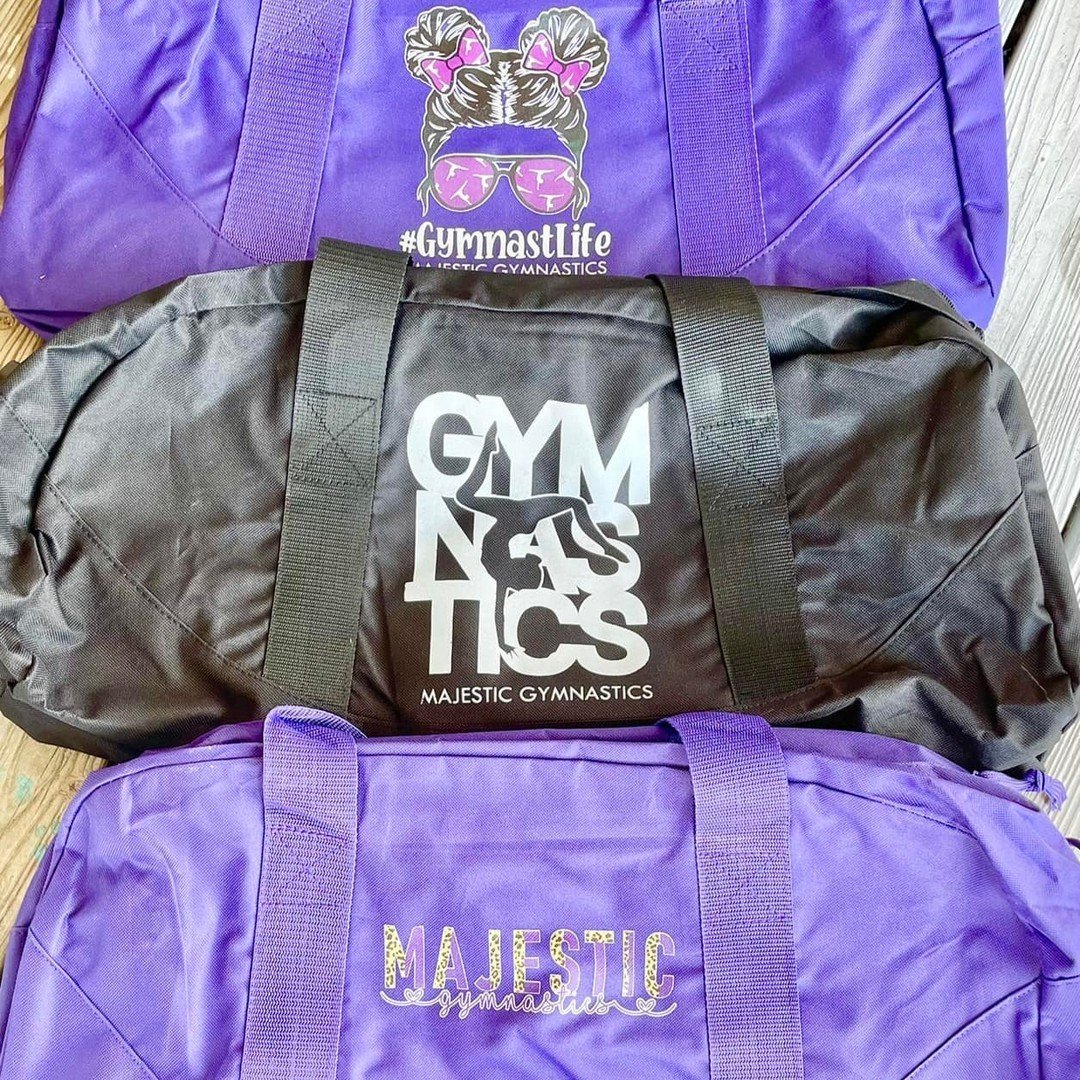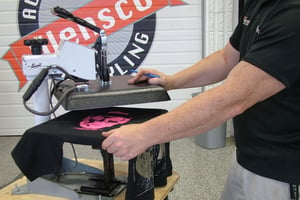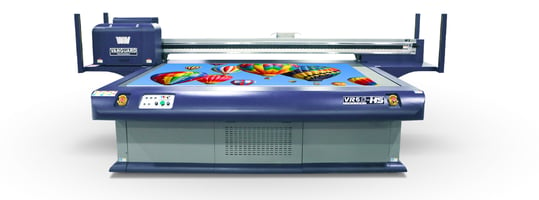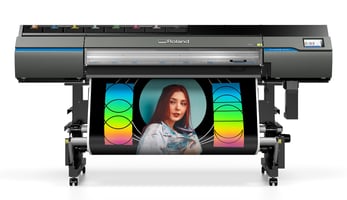If you're looking for a way to take your business to the next level, investing in a heat press is a...
5 Ways to Print Custom Apparel, Home Goods, Accessories, and More

When it comes to creating custom apparel, selecting the right equipment for your business can be a daunting task. The sheer number of options and equipment types can be overwhelming. In this article, we're breaking down the 5 Most Common Methods to Print Custom Apparel to help you decide for your business.
Table of Contents
1. Heat Transfer Vinyl

Heat transfer vinyl (HTV) is a type of vinyl that can be used to create custom designs on fabrics and other materials. It comes in a variety of colors and finishes and can be used to create a variety of effects, such as glitter, flock, and holographic.
HTV is made up of three layers: a carrier sheet, a heat-activated adhesive layer, and a decorative layer. The carrier sheet protects the adhesive layer during cutting and weeding, and is removed after the HTV is applied to the fabric. The adhesive layer melts when heat is applied, and bonds to the fabric. The decorative layer is the visible part of the HTV, and can be any color or finish.
To use HTV, you will need a heat press or a home iron. The first step is to cut the HTV to the desired shape. You can use a vinyl cutter or a craft knife to do this. Once the HTV is cut, you will need to weed it. Weeding is the process of removing the excess HTV from around the design.
Once the HTV is weeded, you can apply it to the fabric. To do this, place the HTV face down on the fabric and then apply heat with the heat press or iron. The heat will activate the adhesive on the back of the HTV, and it will adhere to the fabric.
Here are some of the benefits of using HTV:
-
Easy to use: HTV is easy to use and can be applied by anyone, regardless of their experience level.
-
Versatile: HTV can be used on a variety of materials, including fabric, wood, and metal.
-
Durable: HTV is durable and can withstand repeated washings.
-
Affordable: HTV is an affordable way to create custom designs.
Here are some of the most popular uses for HTV:
-
Custom t-shirts: HTV is a great way to create custom t-shirts for yourself or for your loved ones. You can use HTV to create personalized designs, or to add your favorite quotes or images to your shirts.
-
Apparel accessories: HTV can also be used to create custom apparel accessories, such as hats, bags, and hoodies. This is a great way to add a personal touch to your everyday items.
-
Home décor: HTV can also be used to create custom home décor items, such as pillowcases, curtains, and tablecloths. This is a great way to add a touch of personality to your home.
-
Gifts: HTV is also a great way to create custom gifts for friends and family. You can use HTV to create personalized ornaments, mugs, and other items.
Overall, HTV is a great option for personalizing small projects. However, it is important to be aware of the disadvantages of HTV before you use it:
-
Not suitable for all fabrics: HTV is not suitable for all fabrics. It is best to use on natural fabrics, such as cotton and linen. It can also be used on some synthetic fabrics, but it is important to test the HTV on a small area of the fabric first to make sure it will adhere properly.
-
Can be difficult to weed: Weeding is the process of removing the excess HTV from around the design. It can be difficult to weed HTV, especially if the design is complex.
-
Can be time-consuming to apply: Applying HTV can be time-consuming, especially if the design is large or complex.
-
Can be expensive: HTV can be expensive, especially if you are only using it for a small project.
-
Not as durable as other printing methods: HTV is not as durable as other printing methods, such as screen printing or direct-to-garment printing. It can start to peel or crack after repeated washings.
If you are looking for a creative and affordable way to personalize your belongings, HTV is a great option. With a little creativity, you can use HTV to create unique and lasting gifts for yourself and your loved ones.
2. Direct-to-Garment

Direct-to-garment (DTG) printing is a process of printing designs directly onto garments using specialized inkjet printers. DTG printers typically have a platen designed to hold the garment in a fixed position, and the printer inks are jetted or sprayed onto the textile by the print head. DTG typically requires that the garment be pre-treated with a PTM or Pre-treatment machine allowing for the following:
-
Stronger bond between garment fibers and pigmented inks.
-
Lays down loose fibers to provide for a smoother substrate.
-
Chemically reacts with the inks to promote drying and curing.
DTG printers use aqueous textile inks (water-based chemistry) that require a unique curing process. Since D2 inks are water-based, they work best for printing on natural fibers such as cotton, bamboo, hemp, and linen.
DTG printing offers a number of advantages over traditional printing methods, such as screen printing and embroidery. These advantages include:
-
Full-color printing: DTG printers can print full-color designs, including gradients and photos.
-
No setup costs: There are no setup costs associated with DTG printing, as the designs can be printed directly from a computer.
-
Quick turnaround times: DTG printing can produce prints quickly, making it a good option for short-run projects.
-
High-quality prints: DTG printing can produce high-quality prints with vibrant colors and sharp details.
DTG printing is a popular choice for businesses of all sizes, from small businesses to large corporations. It is also a popular choice for individuals who want to create custom garments.
Here are some of the most popular uses for DTG printing:
-
Custom t-shirts: DTG is a great way to create custom t-shirts for yourself or for your loved ones. You can use DTG to create personalized designs, or to add your favorite quotes or images to your shirts.
-
Apparel accessories: DTG can also be used to create custom apparel accessories, such as hats, bags, and hoodies. This is a great way to add a personal touch to your everyday items.
-
Promotional items: DTG can also be used to create custom promotional items, such as shirts, hats, and bags. This is a great way to promote your business or organization.
-
Events: DTG can also be used to create custom event t-shirts, hats, and other items. This is a great way to show your support for your favorite team or cause.
Overall, DTG printing is a great option for printing high-quality, custom garments. However, it is important to be aware of the disadvantages of DTG printing before you use it:
-
High cost: DTG printers are expensive, and the ink can also be expensive. This can make DTG printing a more expensive option than other printing methods, such as screen printing.
-
Slow printing speed: DTG printers are not as fast as other printing methods, such as screen printing. This can make DTG printing a less efficient option for large orders.
-
Not suitable for all fabrics: DTG printing is not suitable for all fabrics. It is best to use on natural fabrics, such as cotton and linen. It can also be used on some synthetic fabrics, but it is important to test the DTG printer on a small area of the fabric first to make sure it will adhere properly.
-
Not as durable as other printing methods: DTG prints are not as durable as prints produced by other methods, such as screen printing. DTG prints can start to fade or crack after repeated washings.
-
Can be difficult to print complex designs: DTG printers can be difficult to use to print complex designs. This is because the ink can bleed and spread, making it difficult to get sharp lines and details.
If you are looking for a high-quality, affordable way to print custom garments, DTG printing is a great option.
3. Screen Printing

Screen printing is a printing technique that uses a mesh to transfer ink onto a substrate. A blade or squeegee is used to push ink through the open areas of the mesh, which are blocked off by a stencil. This creates an image on the substrate. One color is printed at a time, so multiple screens are used for multi-colored designs.
Here are some of the benefits of screen printing:
-
Versatile: Screen printing can be used on a variety of materials, including fabric, paper, wood, and metal.
-
Durable: Screen prints are durable and can withstand repeated washings.
-
Affordable: Screen printing is an affordable printing method, making it a popular choice for small businesses and individuals.
Here are some of the most popular uses for screen printing:
-
Custom t-shirts: Screen printing is a great way to create custom t-shirts for yourself or for your loved ones. You can use screen printing to create personalized designs, or to add your favorite quotes or images to your shirts.
-
Apparel accessories: Screen printing can also be used to create custom apparel accessories, such as hats, bags, and hoodies. This is a great way to add a personal touch to your everyday items.
-
Promotional items: Screen printing can also be used to create custom promotional items, such as shirts, hats, and bags. This is a great way to promote your business or organization.
-
Events: Screen printing can also be used to create custom event t-shirts, hats, and other items. This is a great way to show your support for your favorite team or cause.
Overall, screen printing is a versatile and durable printing method that can be used to create high-quality prints on a variety of materials. However, it is important to be aware of the disadvantages of screen printing before you use it:
-
Setup costs can be high. Screen printing requires the use of screens, which can be expensive to make. The cost of the screens can be offset by the high volume of prints, but for small orders, the setup costs can be prohibitive.
-
It can be time-consuming. Screen printing is a labor-intensive process. The screens need to be prepared, the ink needs to be applied, and the prints need to be cured. This can take a significant amount of time, especially for large orders.
-
It can be difficult to print complex designs. Screen printing is best for printing simple designs. Complex designs with gradients or fine details can be difficult to print using screen printing.
-
It can be difficult to print on textured surfaces. Screen printing can be difficult to print on textured surfaces, such as denim or corduroy. The ink can be absorbed by the texture, which can make the print look uneven.
-
It can be difficult to print on dark-colored garments. Screen printing can be difficult to print on dark-colored garments. The ink can be difficult to see on dark garments, and the print can be uneven.
Screen printing is a complex process, but it is a versatile and durable printing method that can be used to create high-quality prints on a variety of materials.
If you are looking for a versatile, durable, and affordable printing method, screen printing is a great option.
Dye sublimation printing is a process that uses heat and pressure to transfer dye from a sublimation transfer paper to a substrate, such as polyester or cotton. The dye sublimation printer heats the ink to a high temperature, which causes it to vaporize. The vapor then diffuses into the substrate, where it cools and solidifies. This process results in a high-quality, durable print that is fully integrated with the substrate.
Dye sublimation printing is a versatile process that can be used to print on a variety of materials, including apparel, home goods, and promotional products. It is also a popular choice for printing custom t-shirts and other garments.
Here are some of the benefits of dye sublimation printing:
-
High-quality prints: Dye sublimation printing produces high-quality prints that are vibrant and durable.
-
Versatile: Dye sublimation printing can be used on a variety of materials, including apparel, home goods, and promotional products.
-
Customizable: Dye sublimation printing can be used to create custom prints, making it a popular choice for printing t-shirts and other garments.
-
Cost-effective: Dye sublimation printing can be a cost-effective printing method for high-volume orders.
Here are some of the drawbacks of dye sublimation printing:
-
Setup costs: The initial setup costs for dye sublimation printing can be high, as you will need to purchase a dye sublimation printer and sublimation transfer paper.
-
Ink costs: The cost of ink for dye sublimation printing can be high, as you will need to purchase special dye sublimation ink.
-
Not suitable for all materials: Dye sublimation printing is not suitable for all materials. It is best to use on polyester or cotton, as other materials may not absorb the ink properly.
Overall, dye sublimation printing is a versatile and cost-effective printing method that can be used to create high-quality, custom prints. However, it is important to be aware of the setup costs and ink costs before you use this printing method.
5. Digital Transfer Printing


Digital transfer printing is a process that uses a digital printer to print an image onto a special transfer paper. The transfer paper is then heat-pressed onto a substrate, such as fabric or a hard surface. The heat and pressure cause the ink from the transfer paper to melt and fuse with the substrate, creating a permanent print.
Digital transfer printing is a versatile process that can be used to print on a variety of materials, including fabric, wood, metal, and glass. It is also a popular choice for printing custom t-shirts, mugs, and other items.
Here are some of the benefits of digital transfer printing:
-
High-quality prints: Digital transfer printing produces high-quality prints that are vibrant and durable.
-
Versatile: Digital transfer printing can be used on a variety of materials, including fabric, wood, metal, and glass.
-
Customizable: Digital transfer printing can be used to create custom prints, making it a popular choice for printing t-shirts, mugs, and other items.
-
Cost-effective: Digital transfer printing can be a cost-effective printing method for small to medium-sized orders.
Here are some of the drawbacks of digital transfer printing:
-
Setup costs: The initial setup costs for digital transfer printing can be high, as you will need to purchase a digital printer and transfer paper.
-
Ink costs: The cost of ink for digital transfer printing can be high, as you will need to purchase special transfer ink.
-
Not suitable for all materials: Digital transfer printing is not suitable for all materials. It is best to use on smooth, non-porous surfaces, as other materials may not absorb the ink properly.
Overall, digital transfer printing is a versatile and cost-effective printing method that can be used to create high-quality, custom prints. However, it is important to be aware of the setup costs and ink costs before you use this printing method.
Hope this clears things up for you. If you're interested in Heat Transfer Vinyl (HTV), Direct-to-Garment (DTG), Direct-to-Film (DTF), Dye Sublimation, or Digital Transfer Printing, check out our selection of printers and accessories.





